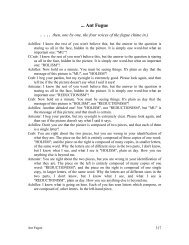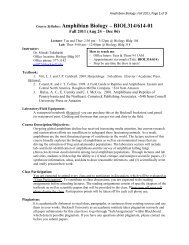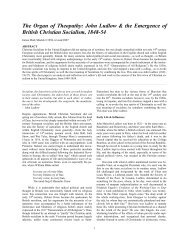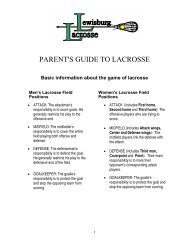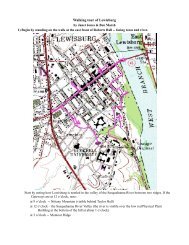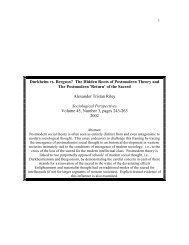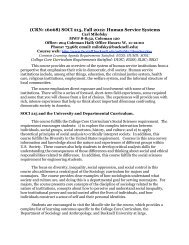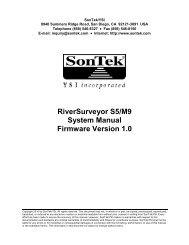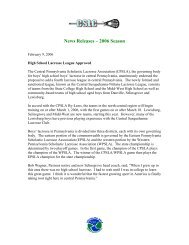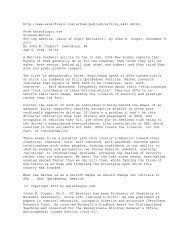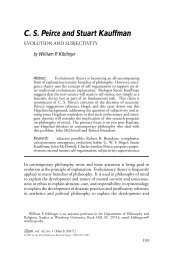The Incumbent Spending Puzzle Christopher S. P. Magee Abstract ...
The Incumbent Spending Puzzle Christopher S. P. Magee Abstract ...
The Incumbent Spending Puzzle Christopher S. P. Magee Abstract ...
Create successful ePaper yourself
Turn your PDF publications into a flip-book with our unique Google optimized e-Paper software.
<strong>The</strong> <strong>Incumbent</strong> <strong>Spending</strong> <strong>Puzzle</strong><br />
<strong>Christopher</strong> S. P. <strong>Magee</strong> ∗<br />
<strong>Abstract</strong><br />
This paper argues that campaign spending by incumbents is primarily useful in<br />
countering spending by challengers. Estimates from models that include an interaction<br />
term between challenger and incumbent spending provide strong support for the<br />
contention that incumbent spending raises the incumbent’s share of the vote only when<br />
he or she faces high levels of spending by the challenger. This result emerges in three<br />
separate estimation procedures: ordinary least squares (in which both challenger and<br />
incumbent spending are treated as exogenous), instrumental variables (treating challenger<br />
and incumbent spending as endogenous), and fixed effects regression (including dummy<br />
variables for each pair of politicians running for office).<br />
Keywords: election outcomes, campaign spending, incumbents, challengers<br />
JEL Classification code: D72<br />
∗<br />
Department of Economics, Bucknell University, Lewisburg, PA 17837; phone (570) 577-1752; fax (570)<br />
577-3451; email: cmagee@bucknell.edu
1. Introduction<br />
Why do incumbents spend money to win reelection to office? <strong>The</strong>y must expect<br />
that it helps them, but academics have found it incredibly difficult to discern any<br />
significant positive impacts of spending by incumbents on their reelection chances. Most<br />
early papers, such as Jacobson (1978), found that challenger spending had sizable<br />
impacts on House of Representatives election outcomes but that spending by incumbents<br />
was relatively unproductive. Levitt (1995, 188) refers to this conclusion as the “long-<br />
held conventional wisdom among political scientists.” Abramowitz (1988) found similar<br />
results for the Senate, where spending by challengers had three times as large an impact<br />
on the election outcome as spending by incumbents. Thus, the conventional wisdom<br />
after scores of articles investigating the topic is that spending by challengers greatly<br />
increases the challenger share of the vote but that spending by incumbents has little or no<br />
effect. Under certain circumstances, Coates (1998) even suggests that additional<br />
spending by incumbents can hurt their chances of winning. Since raising money is a<br />
“disgusting, degrading, demeaning experience” according to Hubert Humphrey, it seems<br />
unlikely that incumbents would go to the effort of soliciting funds unless they believed<br />
the money would help them win reelection.<br />
So are the incumbents misguided, or have academics been unable to find<br />
significant positive impacts of incumbent spending because of data problems? <strong>The</strong> latter<br />
is a serious possibility as there are a number of difficulties in estimating the effects of<br />
campaign spending on election outcomes. <strong>The</strong> most important problem is that<br />
incumbents are likely to spend more money if they are facing a difficult challenge, and<br />
1
thus a drop in their expected share of the vote leads to an increase in their campaign<br />
spending. This means that the election outcome and campaign spending are<br />
simultaneously determined, and the impact of the election returns on spending will lead<br />
to a negative correlation between an incumbent’s vote share and his or her campaign<br />
disbursements. For challengers, the endogeneity issue works the other way. As their<br />
election prospects improve, they find it easier to raise money and thus spending by<br />
challengers may appear to be more effective than it really is. A number of studies have<br />
used simultaneous equations models (usually two-stage least squares) to address the fact<br />
that both the election outcome and spending are endogenous variables. Some of them,<br />
such as Jacobson (1978), uphold the traditional result that incumbent spending has<br />
negligible impacts on election outcomes, although others, such as Green and Krasno<br />
(1988) and Gerber (1998) find that greater spending significantly improves the<br />
incumbent’s share of the vote. Erikson and Palfrey (1998) find that spending by<br />
incumbents who are in their first term in office has large effects on elections (similar to<br />
the impact of spending by challengers). An alternative way around the endogeneity<br />
problem is suggested by Erikson and Palfrey (2000), who show that the endogeneity bias<br />
will be least severe among elections that are expected to be very close. <strong>The</strong>y find that<br />
among this subset of elections, OLS regression reveals a significant positive effect of<br />
incumbent spending on their vote shares. Stratmann (2006) also finds that incumbent<br />
money affects outcomes in state elections in states that limit campaign spending.<br />
A second problem in determining the impact of spending on elections is that the<br />
quality of the politicians involved in an election is difficult to measure. This creates an<br />
2
omitted variable problem because characteristics such as charisma that make a candidate<br />
attractive to voters may also help him or her to raise money. Thus, a candidate’s quality<br />
is positively associated with both money and with vote share, and an inability to control<br />
for quality means that the effects of money on election outcomes will tend to be<br />
overestimated. Levitt (1994) controls for unobserved candidate quality by using a panel<br />
data set and estimating the effects of spending on election outcomes among candidates<br />
who faced each other in more than one election. Assuming that candidate quality is<br />
constant over time, including fixed effects allows Levitt to estimate the impact of<br />
spending on election outcomes after controlling for candidate quality. He finds that<br />
campaign spending has extremely small impacts on vote patterns, whether the spending is<br />
done by incumbents or by challengers. This result does not solve the puzzle about why<br />
incumbents would bother to raise and spend money; instead it would extend the mystery<br />
to include why challengers would take the trouble to raise money.<br />
This paper presents an explanation for the incumbent spending puzzle. I argue<br />
that perceptions of the incumbent are relatively fixed in voters’ minds prior to the<br />
campaign. Thus, the election results depend primarily on how voters see the challenger,<br />
who is much less well-known than the incumbent. Campaign spending can have a big<br />
impact on voters’ views of the challenger but much smaller effects on their views of the<br />
incumbent. Challenger spending during the election, then, is critical for the challenger to<br />
reach a level of familiarity and comfort with the persuadable voters so that those who do<br />
not like the incumbent will show up and vote for the challenger. If the challenger spends<br />
very little, then only die-hard supporters of the challenger’s party will vote against the<br />
3
incumbent. In that case, incumbent spending has almost no impact on the election<br />
outcome. If the challenger spends enough, however, he reaches a threshold level such<br />
that a larger number of persuadable voters see him as a viable candidate. In that case,<br />
incumbent spending can be very useful in portraying the challenger as unsafe, and the<br />
incumbent spending can have a large impact on the election outcome.<br />
<strong>The</strong>se theoretical arguments suggest that researchers need to include an<br />
interaction term between challenger and incumbent spending in models that estimate the<br />
determinants of election outcomes. A few studies, such as Thomas (1989, 1990) and<br />
Coates (1999), have allowed the effect of incumbent spending on election outcomes to<br />
depend on the level of challenger spending, but this paper is the first (to my knowledge)<br />
to do so while treating challenger and incumbent spending as endogenous. <strong>The</strong> empirical<br />
results presented in the paper strongly support the hypothesis that incumbent spending<br />
has a significant influence on the election only when challengers spend a large enough<br />
amount of money.<br />
2. <strong>The</strong>oretical Model<br />
This paper does not attempt to provide a formal theoretical model of voter<br />
decisions and how campaign spending affects them. Instead, I provide a brief discussion<br />
of why the influence of incumbent spending is likely to depend on the level of campaign<br />
spending done by the challenger. Since Downs (1957) provided a detailed analysis of<br />
uncertainty in voter choices, it is well-known that campaign advertisements can have no<br />
impact on elections if voters have perfect information. In such a world, the voters know<br />
4
every detail of the candidates’ policy plans and can determine on their own which<br />
candidate they prefer. When there is uncertainty, however, political advertisements can<br />
provide (selective) information to voters or persuade them to support one candidate over<br />
the others.<br />
<strong>The</strong> greater the uncertainty about a candidate, the more likely that new<br />
information from an advertisement is to change the voter’s opinion. Voters are more<br />
familiar, of course, with incumbents than with challengers. Jacobson (1978), for<br />
example, shows that 57% of voters in 1974 knew the name of their incumbent<br />
representative but only 31% could name the challenger running against him. Thus, voter<br />
opinions about the less well-known challenger are more open to persuasion than are voter<br />
opinions about the incumbent. This argument is consistent with Sciarini and Kriesi<br />
(2003), who find that people whose opinions have crystallized are more resistant to<br />
changing their beliefs. If voters’ views about the incumbent have crystallized, their<br />
opinions may be relatively immobile, in which case advertisements that focus on the<br />
incumbent would have little impact on the election results while those about the<br />
challenger will be more effective. Such a conclusion is supported by evidence from<br />
Erikson and Palfrey (1998), who find that the effect of incumbent spending on election<br />
outcomes are sizable for incumbents in their first re-election campaign but considerably<br />
smaller for more veteran incumbents. <strong>The</strong>y also show that the effect of incumbent<br />
spending on election outcomes declines fairly steadily over the first ten re-election<br />
campaigns. In the tenth term in office, the value of one dollar in campaign spending is<br />
only 14% of the value of a dollar in the first re-election campaign. As the incumbent<br />
5
ecomes better known to voters, in other words, her spending declines in its ability to<br />
influence voters.<br />
For the incumbent, then, advertisements that affect the current election are most<br />
likely to be negative. <strong>Incumbent</strong>s who are not facing a serious challenge will try to build<br />
up their brand-name capital, which Lott (1991) argues is an important source of future<br />
electoral success. <strong>The</strong>y have an incentive to run a largely positive campaign that has<br />
little impact on the current election but may provide gains in their longer-term goal of<br />
continuing to define themselves favorably in voters’ minds. Erikson and Palfrey (1998)<br />
find evidence that higher current levels of spending by incumbents do contribute to their<br />
continued electoral success in future elections. <strong>Incumbent</strong>s who are in a close race, on<br />
the other hand, have a more immediate focus on the current election, and thus their ads<br />
should become more focused on their opponent. <strong>The</strong>y can not afford to spend money<br />
with longer-term considerations in mind if they are facing a serious challenge in the<br />
current election year.<br />
When the incumbent faces a well-funded challenger, then, and his re-election<br />
becomes in doubt, the incumbent spending will be focused on defining the challenger in<br />
the eyes of voters. In this case, the incumbent’s campaign spending will have a<br />
significant impact on the election outcome. When there is little chance of being defeated<br />
in the election, the incumbent will spend money in ways that benefit him in the long run<br />
but that have little effect on the current election outcome. This logic is similar to that in<br />
Grier (1989), who argues that “perhaps incumbents are unwilling to stoop to effective,<br />
but negative, advertisements until they are in a serious contest (i.e. the challenger has<br />
6
spent a significant amount of money).” <strong>The</strong> implication for studies of the impact of<br />
campaign spending on election outcomes is that incumbent spending will have a much<br />
larger impact on election outcomes when the challenger spends a considerable amount of<br />
money than when challengers have little or no campaign expenditures.<br />
This theory is consistent with evidence from Erikson and Palfrey (2000). <strong>The</strong>y<br />
argue that the endogeneity bias (that expected vote shares affect candidates’ spending) is<br />
minimized in races that are expected to be very close. <strong>The</strong>y show that incumbent<br />
spending has a significant effect on election outcomes among these close races and that<br />
the effect of incumbent spending is nearly identical to the effect of challenger spending.<br />
As the expected margin of victory for the incumbent rises, however, the estimated effect<br />
of incumbent spending declines. Since challengers are able to raise and spend<br />
considerably more money if they are expected to be in closely contested races, their<br />
results are consistent with the prediction that incumbent spending will matter most in<br />
races where challengers also spend a lot of money.<br />
This prediction is one that also emerges from the model in Thomas (1989, 1990).<br />
He assumes that only challengers run negative advertisements and that incumbents send<br />
rebuttals. As challengers run more advertisements, the value to the incumbent of being<br />
able to spend money on rebuttals increases. Thus, campaign spending by incumbents<br />
becomes more effective as challenger spending rises. Both papers by Thomas find<br />
empirical support from OLS regressions, but they make no attempt to deal with the<br />
endogeneity problem that higher expected vote shares will influence how much money<br />
the challenger is able to raise and how much the incumbent will choose to raise.<br />
7
Kahn and Kenney (2000) show that incumbent senators actually have fewer<br />
negative advertisements (less than one-third of incumbent ads are negative) than<br />
challengers (more than half of ads are negative). As the race becomes more competitive,<br />
however, the percentage of total advertisements that is negative rises. When local polls<br />
show the candidates to be 30 or more points apart, only 22% of ads are negative, while in<br />
the most competitive races, roughly half of ads are negative.<br />
3. Data<br />
<strong>The</strong> data set used in this study consists of general elections between a Democratic<br />
and a Republican candidate running for the House of Representatives between 1972 and<br />
2006. <strong>The</strong> key relationship is between election outcomes, measured as the incumbent’s<br />
share of the two-party vote, and campaign spending by the incumbent and challenger.<br />
<strong>The</strong> data for these variables from 1980 to 2006 come from the Federal Election<br />
Commission, www.fec.gov. This site also provides information on the cash on hand at<br />
the beginning of the campaign for incumbents and challengers.<br />
Table 1 provides a list of the variables used in the empirical analysis, as well as<br />
each variable’s definition, source, and mean. House incumbents during this time period<br />
received 66% of the 2-party vote on average, which reveals the tremendous advantage<br />
that incumbents have over challengers in general. Another way this advantage is<br />
revealed is in each group’s spending patterns, where challengers spent slightly over<br />
$200,000 in real (2000) dollars while incumbents spent about $535,000 on average.<br />
<strong>Incumbent</strong>s also tended to begin each election period with a monetary advantage. While<br />
8
challengers started a normal campaign with almost no cash on hand, the average<br />
incumbent began a re-election campaign with almost $140,000 available.<br />
<strong>The</strong> typical incumbent was about 52 years old at the start of the election year and<br />
had served over 10 years in the House of Representatives. A few of the incumbents<br />
(1.5%) had the fundraising advantage of being in a leadership position, defined as being<br />
the Speaker of the House, a majority or minority leader, a majority or minority whip, or a<br />
caucus chair. A larger number of the incumbents (8%) were the chair or ranking member<br />
of one of the standing House committees.<br />
It is very difficult to measure the quality of the challenger directly, but this paper<br />
includes many of the variables that are commonly thought to indicate a competitive<br />
challenger such as having held elected office, having been a previous major-party<br />
nominee for the House of Representatives or serving in the House, and being a state<br />
legislator at the time of the election. Almost 20% of the challengers between 1972 and<br />
2006 had been their party’s nominee in a previous general election campaign for the<br />
House of Representatives, 7.4% were state legislators, and over 20% of the challengers<br />
had held elective office. Candidates who had previously served in the U.S. House of<br />
Representatives should be the strongest type of challenger, but they were relatively rare<br />
and accounted for only 1.4% of all challengers.<br />
<strong>The</strong> data on challengers were provided by Gary Jacobson. His data set also<br />
included campaign spending for the 1970’s, which helped to supplement the FEC data<br />
that is available at www.fec.gov from 1980 to today. Information on the incumbents was<br />
9
taken from the U.S. House website (www.house.gov) and from the Biographical<br />
Directory of the U.S. Congress.<br />
4. Results<br />
Table 2 presents the first-stage regressions showing the determinants of spending<br />
by challengers and by incumbents between 1980 and 2006. Elections during the 1970s<br />
are excluded from these regressions because one of the key explanatory variables, the<br />
campaign cash that challengers have available at the beginning of the election, is<br />
unavailable for those years.<br />
<strong>The</strong> results appear quite sensible. Challengers who have held office, were state<br />
legislators, or who were former U.S. representatives spend more money than other<br />
challengers. Challengers spend less money on average when they are in districts that<br />
vote heavily for the incumbent party in presidential races, and when they are facing<br />
incumbents who have been in office for many terms and have large reserves of cash on<br />
hand at the start of the campaign. <strong>The</strong> latter result is consistent with the idea that high<br />
quality challengers who are capable of raising considerable sums of money are deterred<br />
from entering races in which the incumbent has a large war chest available to spend.<br />
Challengers also spend more money when they are facing incumbents in leadership<br />
positions, perhaps because donors are more generous in giving to candidates who are<br />
attempting to unseat well-known leaders of the other party. Finally, challengers who<br />
have cash at the beginning of the campaign end up spending considerably more in their<br />
attempts to unseat the incumbent. <strong>The</strong> estimates actually suggest that a dollar on hand at<br />
10
the start of the campaign is associated with over $12 in extra spending over the course of<br />
the election.<br />
<strong>Incumbent</strong>s clearly spend more money when they are facing serious challenges:<br />
when they are in districts whose voting in presidential elections favors the challenger’s<br />
party, when the challenger has held office, been a state legislator, or been a former<br />
representative, and when the challenger has cash on hand at the start of the campaign.<br />
Young incumbents, and those in office for few terms, also spend more money, as do<br />
those in leadership positions and who are chairs or the ranking members of committees.<br />
<strong>The</strong> latter characteristics make it much easier for the incumbents to raise money. Finally,<br />
incumbents spend more money during the election if they have cash available at its start.<br />
<strong>The</strong>re is a clear time trend upward in spending for both challengers and incumbents, but<br />
there are only a few years in which there is a significant difference between Democrats<br />
and Republicans in spending (once the other variables are controlled for). In 1994,<br />
Democrats spent significantly more than Republicans, while in 2006 the reverse was true.<br />
<strong>The</strong>se estimates are consistent with the theory that candidates who are facing a hostile<br />
political climate (Democrats in 1994 and Republicans in 2006) try to compensate by<br />
spending more money during the election campaign.<br />
<strong>The</strong> instrumental variables that are excluded from the second-stage voting<br />
regressions are dummy variables indicating whether or not the incumbent held a<br />
leadership position in Congress and whether or not the incumbent was the chair or<br />
ranking member of a standing committee, the incumbent’s age, the reciprocal of the<br />
number of districts in the state, and the cash on hand at the start of the election. <strong>The</strong>se<br />
11
instrumental variables are shown in bold in the table. <strong>The</strong> F-statistics testing the<br />
hypothesis that all the coefficients on the instrumental variables are zero are shown at the<br />
bottom of the table ( F = 39 in the challenger spending regression and F = 120 for<br />
incumbent spending). <strong>The</strong>se are large enough to allay fears that the instruments are<br />
weak, and Table 3 presents additional tests for weak instruments and for instrument<br />
validity.<br />
Table 3 presents the results of the voting regression. <strong>The</strong> dependent variable is<br />
the incumbent’s share of the two-party vote in the district. <strong>The</strong> first two columns of<br />
numbers present the coefficient estimates from ordinary least squares regression, in<br />
which the candidate spending variables are assumed to be exogenous. <strong>The</strong> first column<br />
shows the common result in the literature: spending by challengers significantly reduces<br />
the incumbent’s share of the vote, but spending by incumbents also appears to hurt the<br />
incumbent, and both coefficients are statistically significant at the 1% level. This result is<br />
likely driven by the fact that the OLS regression treats spending by incumbents as<br />
exogenous when in reality the incumbents increase their efforts to raise money and spend<br />
it in the campaign as the race tightens, or their share of the vote declines.<br />
<strong>The</strong> second column adds an interaction term between challenger spending and<br />
incumbent spending. <strong>The</strong> coefficient on the interaction term is positive and statistically<br />
significant at the 1% level, which means that the positive effect of incumbent spending<br />
on the incumbent’s share of the vote rises as challenger spending increases.<br />
Equivalently, the reduction in the incumbent’s share of the vote caused by an increase in<br />
challenger spending gets smaller as incumbent spending increases. <strong>The</strong> result is<br />
12
consistent with the hypothesis proposed in this paper that spending by incumbents is<br />
primarily useful in countering spending by challengers.<br />
<strong>The</strong> two-stage least squares estimates are very similar. Without the interaction<br />
term in the model, challenger spending significantly reduces the incumbent’s share of the<br />
vote (an extra $100,000 in challenger money lowers the incumbent’s vote share by 0.75<br />
percentage points). Extra spending by the incumbent has no significant impact on her<br />
share of the votes received, with the point estimate suggesting that an extra $100,000<br />
reduces the incumbent vote share by 0.01 percentage points. This insignificant<br />
coefficient is more plausible than the significantly negative coefficient in the OLS<br />
column 1 results.<br />
Adding the interaction term shows that the impact of challenger spending on the<br />
election depends on how much the incumbent spends. <strong>The</strong> interaction term is positive<br />
and statistically significant, so a given increase in challenger spending has a smaller and<br />
smaller impact on the election outcome as the incumbent spends more money. Based on<br />
the estimates, the impact of spending by challengers is<br />
∂incumbent<br />
vote share<br />
= −2<br />
. 332 + 0.<br />
087 * incumbent spending . Thus, when incumbents<br />
∂challenger<br />
spending<br />
spend nothing in the race, $100,000 extra in spending by the challenger subtracts about<br />
2.3 percentage points from the incumbent’s share of the vote. <strong>The</strong> spending variables are<br />
measured in hundreds of thousands of dollars, so when an incumbent spends $1M<br />
(spending = 10), the extra $100,000 in challenger spending subtracts 1.46 percentage<br />
points from the incumbent’s share of the vote. <strong>The</strong> estimates suggest that if an incumbent<br />
13
spends $2.7M, then he can completely neutralize challenger spending<br />
∂incumbent<br />
vote share<br />
( = 0).<br />
A little over 1% (54 of 4,557) of the incumbents in the<br />
∂challenger<br />
spending<br />
regression spent more than this amount.<br />
An alternative way of viewing the results is that the benefit of incumbent<br />
spending rises with challenger spending. <strong>The</strong> effect of incumbent spending on the<br />
∂incumbent<br />
vote share<br />
election outcome is = −0<br />
. 159 + 0.<br />
087 * challenger spending .<br />
∂incumbent<br />
spending<br />
Thus, spending by the incumbent raises his share of the vote if the challenger spends<br />
more than $182,000. Challengers spending less than that amount of money are not viable<br />
candidates. Of the 3,106 races in the sample in which a challenger spent less than<br />
$182,000, challengers won only 6 (0.19%) of them. Challengers won 219 of the 1,451<br />
races (15%), on the other hand, in which they spent more than $182,000. Thus, spending<br />
by incumbents improves their share of the vote in virtually all races in which the<br />
challenger has a chance of winning. When a challenger spends $1M, an extra $100,000<br />
in spending by the incumbent raises her share of the vote by 0.7 percentage points.<br />
One question common in the literature is whether incumbent spending and<br />
challenger spending have an equal impact (but in opposite directions) on the vote<br />
outcome. <strong>The</strong> 2SLS estimates in the last column of Table 3 suggest that the answer to<br />
this question depends on the level of spending by each candidate. At the average values<br />
of spending for challengers and incumbents, the estimated impact of $100,000 in extra<br />
campaign spending by challengers (1.87 percentage points more for the challenger) is<br />
much larger than the estimated impact of a similar increase in spending for the incumbent<br />
14
(0.02 percentage points more for the incumbent). Looking at all of the observations in<br />
Table 3, only 3% of the races (144 out of 4557) had spending levels that were high<br />
enough so that the marginal impact of incumbent spending was estimated to be greater<br />
than the impact of challenger spending. Thus, in the vast majority of cases, the estimates<br />
support the conventional wisdom that challenger spending is more effective than<br />
incumbent spending in winning over voters.<br />
<strong>The</strong>re is always a concern about performing two-stage least squares regression<br />
that the results can be driven by poor instruments or by the choice of instruments in the<br />
model. Several things are reassuring about the two-stage least squares results presented<br />
in Table 3, however. First, the estimates are similar to those in the OLS regressions.<br />
Each type of regression has a potential source of bias. <strong>The</strong> OLS regressions suffer from<br />
endogeneity bias if the spending variables are correlated with the error term in the voting<br />
equation. <strong>The</strong> last row in Table 3 presents a Wu-Hausman test of endogeneity for the<br />
two spending variables, and the test statistic is significant at the 5% level. This result<br />
indicates that it is inappropriate to treat the spending variables as exogenous, and OLS<br />
regressions are biased. <strong>The</strong> two-stage least squares regressions are biased as well<br />
(although they are consistent), and weak instruments increase the size of the bias. <strong>The</strong><br />
estimates shown in the table are based on strong instruments, however, as the very high<br />
Cragg-Donald Wald F statistic (a statistic used to identify weak instruments) shown near<br />
the bottom of the table reveals. It is reassuring that the OLS and two-stage least squares<br />
estimates tell the same story about the impact of spending on election outcomes. In<br />
addition, none of the variables used as instruments is statistically significant at the 5%<br />
15
level when included in the voting equation. Another reassuring aspect of the two-stage<br />
least squares estimates is that they pass the overidentification test (the Sargan statistic is<br />
shown near the bottom of Table 3). A significant test statistic here would indicate that<br />
the instrumental variables are correlated with the error term in the election equation,<br />
which would violate a critical assumption necessary for the IV regression to provide<br />
consistent estimates. Since the Sargan statistic in this case is not significant, the<br />
overidentification test does not provide any evidence that the instruments are invalid.<br />
A way to show the robustness of the results is to re-estimate the two-stage least<br />
squares regressions using different combinations of the instruments. With five<br />
instruments, there are 25 different combinations with at least two instruments. When the<br />
two-stage least squares regressions are re-estimated 25 times using these different<br />
combinations, the coefficient on the interaction term remains close to that in Table 3,<br />
ranging from 0.069 to 0.109.<br />
<strong>The</strong> other coefficients in Table 3 are fairly consistent across the regressions are<br />
and intuitive. An extra percentage point in the district’s vote for the presidential<br />
candidate from the House incumbent’s party translates into roughly 0.4 percentage points<br />
more for the House incumbent in his reelection bid. An incumbent who begins the<br />
campaign with a large amount of cash on hand does significantly better in the election,<br />
even after controlling for how much each candidate ultimately spends. This could be<br />
caused by a large war chest scaring off quality challengers, which Epstein and Zemsky<br />
(1995) show is possible theoretically. This result is consistent with Box-Steffensmeier<br />
(1996), who finds that larger incumbent war chests deter entry by high quality<br />
16
challengers. Milyo and Groseclose (1999), on the other hand, conclude that incumbent<br />
wealth does not deter challengers, and Goodliffe (2001) finds no significant effect of war<br />
chests on the probability of entry by high quality challengers once the incumbent’s<br />
previous election results are controlled for.<br />
Experienced challengers pose more of a threat to the incumbent: challengers get a<br />
larger share of the vote if they were the previous nominee had held office, or had been a<br />
state legislator. Finally, Republicans did well, all else equal, in 1980 and 1984 (President<br />
Reagan’s election year coattails), 1994 (President Clinton’s first midterm election and the<br />
Contract with America), and 2002 (President Bush’s popularity following September 11<br />
and the invasion of Afghanistan), while Democrats did well in most of the remaining<br />
years, particularly in the midterm elections other than 2002 under Republican Presidents<br />
(1982, 1986, 1990, and 2006).<br />
A second way of examining the effect of challenger and incumbent spending<br />
while controlling for a potential endogeneity problem was suggested by Levitt (1994). If<br />
there are unobserved characteristics of candidates that are correlated with both their vote-<br />
winning and fundraising abilities, then the spending variables will be correlated with the<br />
error term in the election outcome equation. Thus, the spending variables suffer from<br />
omitted variable bias because candidate quality is not controlled for. Candidate quality<br />
can reasonably be assumed to be relatively constant over time, however, which suggests<br />
that fixed effects can be used to control for candidate quality.<br />
Table 4 presents the results of estimates from a sample of elections in which the<br />
same challenger and incumbent faced each other in more than one election. <strong>The</strong>re were<br />
17
1373 such elections between 1972 and 2006. Levitt (1994) uses fixed effects to control<br />
for both unobserved candidate pair and district characteristics, and hence he excludes<br />
districts that were redrawn in between the two elections in which the same pair of<br />
candidates faced off. This paper uses the district vote in presidential elections as a<br />
measure of the partisan makeup of the district and how that favors (or hurts) the<br />
incumbent. Thus, the sample used in Table 4 includes observations in which a repeat<br />
election was divided by redistricting. <strong>The</strong> fixed effects are interpreted as capturing the<br />
relative political talent of the two candidates running for office.<br />
<strong>The</strong> first two columns present OLS estimates on this sample of 1373 repeat<br />
elections, and the results are similar to those in Table 3. Once again, challenger spending<br />
significantly reduces the incumbent’s share of the vote, and the interaction term between<br />
challenger and incumbent spending is positive and statistically significant.<br />
<strong>The</strong> last two columns present estimates including fixed effects for each candidate<br />
pair. When candidate pair fixed effects are included but there is no interaction term<br />
between the spending variables (column 3), the coefficient on challenger spending<br />
remains negative and statistically significant. <strong>The</strong> point estimate is about one-third as<br />
large as that in the OLS estimate of column 1, which shows that controlling for<br />
unobserved candidate quality does reduce the estimated impact of challenger money on<br />
election outcomes. With candidate fixed effects, the coefficient on incumbent spending<br />
is now positive and statistically significant at the 10% level. <strong>The</strong> point estimate suggests<br />
that an extra $100,000 in spending by the incumbent raises her share of the vote by about<br />
0.1 percentage points. <strong>The</strong>se estimates suggest that the impact of incumbent spending on<br />
18
the election outcome is much smaller than the effect of challenger spending. It would<br />
take roughly $3.50 in spending by the incumbent to offset $1 in extra spending by the<br />
challenger.<br />
<strong>The</strong> final column shows the same result as in the ordinary least squares and<br />
instrumental variables regressions: the coefficient on the interaction term between<br />
challenger and incumbent spending is positive and statistically significant. Once again,<br />
this supports the view that incumbent spending is most useful as a way to counteract<br />
spending by the challenger. <strong>The</strong> impact of spending by challengers on election outcomes<br />
∂incumbent<br />
vote share<br />
is estimated to be: = −0<br />
. 654 + 0.<br />
017 * incumbent spending .<br />
∂challenger<br />
spending<br />
Challenger spending is most effective when it is not countered with any spending by the<br />
incumbent.<br />
<strong>Incumbent</strong> spending has no significant impact on the election when challengers<br />
spend nothing. <strong>The</strong> effect of incumbent spending on the election outcome is<br />
∂incumbent<br />
vote share<br />
= −0<br />
. 031+<br />
0.<br />
017 * challenger spending . <strong>Spending</strong> by the<br />
∂incumbent<br />
spending<br />
incumbent, then, raises his share of the vote if the challenger spends more than $182,000,<br />
which is identical to the estimate from Table 3 about when spending by the incumbent<br />
begins to have a positive effect on her share of the vote.<br />
<strong>The</strong> results are thus remarkably consistent across different estimation methods.<br />
Whether using ordinary least squares, instrumental variables, or fixed effects regressions,<br />
incumbent spending is found to have a significant effect on election outcomes only in<br />
those races where challengers spend a lot of money.<br />
19
Figure 1 illustrates the effects (estimated in Tables 3 and 4) of incumbent<br />
spending on the share of the two-party vote the incumbent receives. <strong>The</strong> figure shows the<br />
marginal effect of incumbent spending on vote share for different levels of challenger<br />
spending. For both the two-stage least squares estimates and the fixed-effect estimates,<br />
the impact of incumbent spending on the vote share rises and challengers spend more<br />
money. While the effect of extra incumbent spending is almost exactly zero at $200,000<br />
spending by the challenger, the impact of an extra $100,000 spent by the incumbent rises<br />
to 1.6 percentage points in the 2SLS regression (0.3 percentage points in the fixed-effect<br />
regression) when the challenger spends $2 million.<br />
Figure 2 shows that increased spending by the incumbent is able to reduce the<br />
effectiveness of spending by the challenger. When an incumbent spends nothing, the<br />
models estimate that $100,000 of spending by the challenger raises her share of the vote<br />
by 2.3 percentage points in the 2SLS regression or by 0.65 percentage points in the fixed<br />
effects regression. If the incumbent spends $2 million, on the other hand, the gain to the<br />
challenger of an extra $100,000 in campaign money is only between 0.3 percentage<br />
points (from the fixed effects regression) and 0.6 percentage points (from the 2SLS<br />
regression).<br />
<strong>The</strong> figures reveal the much smaller estimated impacts of spending on election<br />
outcomes in the fixed effects regression than in the instrumental variables regression.<br />
This result may be caused by the fact that the fixed effects do a better job than the 2SLS<br />
regression of controlling for differences in candidate quality. <strong>The</strong> estimates are<br />
20
consistent with the results in Levitt (1994), who also found very small effects of money<br />
on election outcomes when he included candidate-pair fixed effects.<br />
5. Conclusion<br />
This paper develops and tests a theory that incumbent spending has the largest<br />
immediate impact on election outcomes when the incumbent is forced to respond to a<br />
serious challenge. Since challengers are less well-known, voter opinions about the<br />
challenger are more flexible than voter opinions about the incumbent. In races where<br />
challengers have enough money to spend introducing themselves to voters, incumbents<br />
have an incentive to run advertisements seeking to define the challenger in less positive<br />
ways. <strong>The</strong>se negative advertisements can be very effective and can have a large impact<br />
on the current election. <strong>Incumbent</strong>s will not spend money on negative advertisements,<br />
however, if the challenger does not have the financial resources to be competitive. In<br />
such cases, the incumbent will likely run a positive campaign designed to build up her<br />
own brand-name capital. This type of campaign can provide some long-term gains for<br />
the incumbent but likely has a relatively small impact on the current election.<br />
This theory thus provides an explanation of the puzzle surrounding campaign<br />
spending by incumbents: why they would bother to raise and spend money if their<br />
expenditures have no (or even negative) effects on their election chances as most<br />
previous papers have found. <strong>The</strong> theory’s prediction that incumbent spending is most<br />
effective when challenger spending is considerable finds remarkably consistent support<br />
from the empirical tests. In ordinary least squares, instrumental variables, and fixed-<br />
21
effects regressions, campaign spending by incumbents has a significant positive effect on<br />
the incumbent’s share of the vote only when challengers spend a sufficiently large<br />
amount of money in their election efforts. In both the instrumental variables and fixed<br />
effects regressions, incumbent spending begins to have a positive impact on the<br />
incumbent’s share of the vote when the challenger spends more than $182,000.<br />
One other interesting result that emerges from the estimates is that incumbent war<br />
chests appear to deter entry by high quality challengers. When an incumbent has a large<br />
amount of money on hand at the beginning of the campaign, the challenger has<br />
significantly lower levels of campaign spending during the election and receives a<br />
significantly smaller share of the vote, even after controlling for both candidates’<br />
spending levels.<br />
22
Table 1: Description of the data set<br />
Variable Definition Source Mean<br />
<strong>Incumbent</strong> vote share<br />
<strong>Incumbent</strong>’s share of two-party<br />
vote<br />
www.fec.gov 66.041<br />
Challenger spending<br />
Challenger campaign spending in<br />
100,000s of real 2000 $<br />
www.fec.gov 2.032<br />
<strong>Incumbent</strong> spending<br />
<strong>Incumbent</strong> campaign spending in<br />
100,000s of real 2000 $<br />
www.fec.gov 5.347<br />
Challenger*incumbent<br />
spending<br />
Interaction term between<br />
www.fec.gov<br />
incumbent and challenger spending<br />
23.322<br />
Terms incumbent has served in Biographical<br />
<strong>Incumbent</strong> terms House of Representative prior to Directory of the U.S. 5.155<br />
election year<br />
Congress<br />
Beginning cash,<br />
incumbent<br />
Money incumbent has at start of<br />
campaign in 100,000s of real 2000 www.fec.gov<br />
$<br />
Money challenger has at start of<br />
1.394<br />
Beginning cash, challenger campaign in 100,000s of real 2000 www.fec.gov<br />
$<br />
0.005<br />
Previous nominee,<br />
challenger<br />
=1 if challenger was party’s<br />
previous nominee for House of<br />
Representatives<br />
www.house.gov 0.196<br />
Held office, challenger<br />
=1 if challenger has held elective<br />
Gary Jacobson data<br />
office prior to current election year<br />
=1 if challenger was a state<br />
0.208<br />
State legislator, challenger legislator prior to current election<br />
year<br />
Gary Jacobson data 0.074<br />
Former representative,<br />
challenger<br />
=1 if challenger was a former<br />
member of the U.S. House of<br />
Representatives<br />
Gary Jacobson data 0.014<br />
Leadership position,<br />
incumbent<br />
=1 if incumbent is Speaker,<br />
Majority or minority leader or<br />
whip, caucus chair<br />
www.house.gov 0.015<br />
Chair/ranking committee<br />
member<br />
=1 if incumbent is chair or ranking<br />
member of a standing House www.house.gov<br />
committee<br />
0.080<br />
1/number of districts<br />
1 divided by the number of House<br />
districts in the state<br />
www.house.gov 0.115<br />
Age of incumbent<br />
Biographical<br />
<strong>Incumbent</strong>’s age at start of election<br />
Directory of the U.S.<br />
year<br />
Congress<br />
51.753<br />
23
Table 2: First-stage regressions determining challenger and incumbent spending<br />
Variables Challenger <strong>Spending</strong> <strong>Incumbent</strong> <strong>Spending</strong><br />
<strong>Incumbent</strong> party presidential vote share -0.085 *** -0.086 ***<br />
<strong>Incumbent</strong> terms -0.069 *** -0.045 *<br />
Beginning cash, incumbent -0.116 *** 0.153 ***<br />
Previous nominee, challenger 0.073 -0.058<br />
Held office, challenger 1.627 *** 2.153 ***<br />
State legislator, challenger 1.051 *** 0.644 **<br />
Former representative, challenger 3.520 *** 3.192 ***<br />
Leadership position, incumbent 1.267 *** 11.448 ***<br />
Chair or ranking committee member -0.087 0.961 ***<br />
(1/number of districts) 0.185 -0.718<br />
Age of incumbent 0.005 -0.035 ***<br />
Beginning cash, challenger 12.196 *** 6.895 ***<br />
Year 1982 0.116 0.359<br />
Year 1984 0.359 0.974 *<br />
Year 1986 0.814 * 2.027 ***<br />
Year 1988 0.823 * 2.471 ***<br />
Year 1990 0.431 2.369 ***<br />
Year 1992 0.551 3.211 ***<br />
Year 1994 0.614 2.387 ***<br />
Year 1996 1.866 *** 4.543 ***<br />
Year 1998 1.352 *** 4.631 ***<br />
Year 2000 2.446 *** 6.088 ***<br />
Year 2002 2.408 *** 5.985 ***<br />
Year 2004 1.763 *** 7.124 ***<br />
Year 2006 4.158 *** 10.142 ***<br />
Democrat * Year 1980 0.729 * -0.283<br />
Democrat * Year 1982 0.594 0.347<br />
Democrat * Year 1984 0.487 0.443<br />
Democrat * Year 1986 -0.353 -0.228<br />
Democrat * Year 1988 -0.424 -0.380<br />
Democrat * Year 1990 0.105 -0.047<br />
Democrat * Year 1992 0.115 0.258<br />
Democrat * Year 1994 1.062 ** 1.343 ***<br />
Democrat * Year 1996 -0.285 -0.904 *<br />
Democrat * Year 1998 0.311 -0.947 *<br />
Democrat * Year 2000 -0.757 * -0.847 *<br />
Democrat * Year 2002 -1.295 *** -0.578<br />
Democrat * Year 2004 0.103 -1.205 **<br />
Democrat * Year 2006 -2.665 *** -3.869 ***<br />
Constant 1.278 *** 4.891 ***<br />
Observations 4557 4557<br />
R-squared 0.219 0.354<br />
F-statistic for instrumental variables 38.79 *** 120.46 ***<br />
*, **, *** indicate that the coefficient is statistically significant at the 10%, 5%, 1% levels<br />
24
Table 3: OLS and Instrumental Variable regressions<br />
Variable Ordinary Least Squares Two-Stage Least Squares<br />
Challenger spending -0.659 *** -1.291 *** -0.748 *** -2.332 ***<br />
<strong>Incumbent</strong> spending -0.156 *** -0.337 *** -0.011 -0.159 *<br />
Challenger*incumbent spending 0.034 *** 0.087 ***<br />
<strong>Incumbent</strong> party presidential vote 0.431 *** 0.404 *** 0.436 *** 0.344 ***<br />
<strong>Incumbent</strong> terms -0.012 -0.028 -0.016 -0.087 **<br />
Beginning cash, incumbent 0.268 *** 0.235 *** 0.232 *** 0.145 **<br />
Previous nominee, challenger -0.885 *** -0.906 *** -0.875 *** -0.630 **<br />
Held office, challenger -1.985 *** -1.598 *** -2.164 *** -0.971 *<br />
State legislator, challenger -1.303 *** -1.127 *** -1.283 *** -0.415<br />
Former representative, challenger -1.162 -0.431 -1.312 -0.144<br />
Year 1982 -6.372 *** -6.047 *** -6.415 *** -6.073 ***<br />
Year 1984 0.509 0.750 0.404 0.789<br />
Year 1986 -1.883 ** -1.360 * -2.090 *** -1.069<br />
Year 1988 -0.090 0.432 -0.337 0.601<br />
Year 1990 -5.695 *** -5.272 *** -5.958 *** -5.456 ***<br />
Year 1992 -5.315 *** -4.651 *** -5.696 *** -5.041 ***<br />
Year 1994 0.654 1.248 * 0.394 1.108<br />
Year 1996 -4.525 *** -3.699 *** -4.996 *** -3.195 ***<br />
Year 1998 -3.244 *** -2.263 *** -3.762 *** -2.338 **<br />
Year 2000 -1.502 ** -1.083 -2.127 ** 0.026<br />
Year 2002 -0.317 0.450 -0.908 1.312<br />
Year 2004 -2.812 *** -1.841 ** -3.638 *** -1.992 *<br />
Year 2006 -6.268 *** -5.777 *** -7.303 *** -4.777 ***<br />
Democrat * Year 1980 -2.848 *** -2.525 *** -2.722 *** -1.879 **<br />
Democrat * Year 1982 8.191 *** 8.369 *** 8.217 *** 8.742 ***<br />
Democrat * Year 1984 -3.384 *** -3.079 *** -3.367 *** -2.835 ***<br />
Democrat * Year 1986 4.491 *** 4.410 *** 4.515 *** 3.968 ***<br />
Democrat * Year 1988 0.938 0.785 0.956 0.348<br />
Democrat * Year 1990 3.242 *** 3.273 *** 3.265 *** 3.264 ***<br />
Democrat * Year 1992 2.515 *** 2.565 *** 2.496 *** 2.502 ***<br />
Democrat * Year 1994 -6.967 *** -6.554 *** -7.062 *** -6.087 ***<br />
Democrat * Year 1996 3.945 *** 4.030 *** 4.072 *** 3.900 ***<br />
Democrat * Year 1998 3.254 *** 3.079 *** 3.433 *** 3.651 ***<br />
Democrat * Year 2000 2.051 *** 2.356 *** 2.119 *** 1.584 **<br />
Democrat * Year 2002 -1.463 ** -1.342 * -1.497 ** -2.645 **<br />
Democrat * Year 2004 2.485 *** 2.512 *** 2.686 *** 2.811 ***<br />
Democrat * Year 2006 8.079 *** 8.293 *** 8.426 *** 7.307 ***<br />
Constant 67.951 *** 69.207 *** 67.611 *** 70.072 ***<br />
Observations 4557 4557 4557 4557<br />
R-squared 0.596 0.632 0.506 0.510<br />
Weak Identification test 37.873<br />
Overidentification test 4.480<br />
Wu-Hausman endogeneity test of spending variables 3.112 **<br />
*, **, *** indicate that the coefficient is statistically significant at the 10%, 5%, 1% levels<br />
25
Table 4: Regressions using sample of repeat elections<br />
Variable Ordinary Least Squares Fixed Effects for Candidate Pair<br />
Coefficients Coefficients Coefficients Coefficients<br />
Challenger spending -1.017 *** -1.995 *** -0.342 *** -0.654 ***<br />
<strong>Incumbent</strong> spending -0.116 ** -0.497 *** 0.098 * -0.031<br />
Challenger*incumbent spending 0.065 *** 0.017 ***<br />
<strong>Incumbent</strong> party presidential vote 0.443 *** 0.394 *** 0.334 *** 0.326 ***<br />
Year 1974 -8.686 *** -7.553 *** -9.057 *** -8.819 ***<br />
Year 1976 -2.943 -2.383 -4.639 *** -4.298 ***<br />
Year 1978 -1.164 -0.075 -0.761 -0.202<br />
Year 1980 5.981 *** 6.528 *** 0.807 1.602<br />
Year 1982 -2.302 -0.155 -5.878 *** -4.819 ***<br />
Year 1984 4.454 ** 5.456 *** -1.105 -0.052<br />
Year 1986 1.057 2.861 -2.105 -1.044<br />
Year 1988 3.722 * 5.490 *** -1.375 -0.123<br />
Year 1990 -2.908 -1.614 -7.492 *** -6.350 ***<br />
Year 1992 -1.217 1.001 -3.861 * -2.382<br />
Year 1994 5.449 ** 7.292 *** 0.978 2.390<br />
Year 1996 0.822 3.265 * -3.408 -1.878<br />
Year 1998 2.858 4.608 ** -2.225 -0.789<br />
Year 2000 4.265 ** 6.402 *** -2.163 -0.699<br />
Year 2002 5.171 ** 7.138 *** 0.061 1.421<br />
Year 2004 2.658 4.686 ** -1.300 0.096<br />
Year 2006 1.096 0.409 -5.689 ** -4.717 *<br />
Democrat * Year 1972 1.955 2.308 -5.050 ** -4.319 **<br />
Democrat * Year 1974 13.937 *** 12.424 *** 8.365 *** 8.693 ***<br />
Democrat * Year 1976 6.684 *** 6.734 *** 5.484 *** 5.729 ***<br />
Democrat * Year 1978 2.699 2.639 * 0.547 0.706<br />
Democrat * Year 1980 -5.629 *** -4.636 *** -3.096 ** -2.954 **<br />
Democrat * Year 1982 7.217 *** 6.584 *** 7.534 *** 7.552 ***<br />
Democrat * Year 1984 -3.279 ** -2.495 * -0.721 -0.686<br />
Democrat * Year 1986 6.408 *** 6.075 *** 5.230 *** 5.315 ***<br />
Democrat * Year 1988 0.679 -0.021 3.254 ** 3.137 **<br />
Democrat * Year 1990 4.954 *** 4.646 *** 6.268 *** 6.253 ***<br />
Democrat * Year 1992 2.706 2.277 1.523 1.340<br />
Democrat * Year 1994 -7.521 *** -7.098 *** -4.901 *** -5.028 ***<br />
Democrat * Year 1996 3.575 *** 3.187 ** 5.155 *** 4.930 ***<br />
Democrat * Year 1998 2.675 * 2.189 * 5.026 *** 4.841 ***<br />
Democrat * Year 2000 3.252 ** 2.102 5.978 *** 5.648 ***<br />
Democrat * Year 2002 -1.316 -1.497 -0.080 -0.176<br />
Democrat * Year 2004 3.183 ** 3.222 *** 2.634 2.610<br />
Democrat * Year 2006 6.985 *** 9.559 *** 9.505 *** 9.831 ***<br />
Constant 62.416 *** 64.023 *** 63.962 *** 63.929 ***<br />
Observations 1373 1373 1373 1373<br />
R-squared 0.616 0.676 0.523 0.579<br />
*, **, *** indicate that the coefficient is statistically significant at the 10%, 5%, 1% levels<br />
26
Marginal effects<br />
Figure 1: Effect of incumbent spending on incumbent vote share<br />
2.4<br />
2<br />
1.6<br />
1.2<br />
0.8<br />
0.4<br />
0<br />
-0.4<br />
Figure 2: Effect of challenger spending on challenger vote share<br />
Marginal effects<br />
0 2 4 6 8 10 12 14 16 18 20<br />
Challenger spending<br />
2.4<br />
2<br />
1.6<br />
1.2<br />
0.8<br />
0.4<br />
0<br />
-0.4<br />
Table 3, 2SLS estimates<br />
Table 4, fixed effect estimates<br />
0 2 4 6 8 10 12 14 16 18 20<br />
<strong>Incumbent</strong> spending<br />
27<br />
Table 3, 2SLS estimates<br />
Table 4, fixed effect estimates
References<br />
Abramowitz, Alan, 1988, “Explaining Senate Election Outcomes, American Political<br />
Science Review 88, 385 – 403.<br />
Box-Steffensmeier, Janet, 1996, “A Dynamic Analysis of the Role of War Chests in<br />
Campaign Strategy,” American Journal of Political Science 40 (2), 352 – 371.<br />
Coates, Dennis, 1998, “Additional <strong>Incumbent</strong> <strong>Spending</strong> Really Can Harm (at Least<br />
Some) <strong>Incumbent</strong>s: An Analysis of Vote Share Maximization,” Public Choice 95,<br />
63 – 87.<br />
Coates, Dennis, 1999, “<strong>The</strong> Effects of Campaign <strong>Spending</strong> on Electoral Outcomes: A<br />
Data Envelopment Analysis,” Public Choice 99, 15 – 37.<br />
Epstein, David, and Peter Zemsky, 1995, “Money Talks: Deterring Quality Challengers<br />
in Congressional Elections,” American Political Science Review 89 (2), 295 –<br />
308.<br />
Erikson, Robert, and Thomas Palfrey, 2000, “Equilibria in Campaign <strong>Spending</strong> Games:<br />
<strong>The</strong>ory and Data,” American Political Science Review 94 (3), 595 – 609.<br />
Gerber, Alan, 1998, “Estimating the Effect of Campaign <strong>Spending</strong> on Senate Election<br />
Outcomes using Instrumental Variables,” American Political Science Review 92<br />
(2), 401 – 411.<br />
Goodliffe, Jay, 2001, “<strong>The</strong> Effect of War Chests on Challenger Entry in U.S. House<br />
Elections,” American Journal of Political Science 45 (4), 830 – 844.<br />
28
Green, Donald, and Jonathan Krasno, 1988, “Salvation for the Spendthrift <strong>Incumbent</strong>:<br />
Reestimating the Effects of Campaign <strong>Spending</strong> in the House,” American Journal<br />
of Political Science 32 (4), 884 – 907.<br />
Grier, Kevin, 1989, “Campaign <strong>Spending</strong> and Senate Elections, 1978-84,” Public Choice<br />
63, 201 – 219.<br />
Jacobson, Gary, 1978, “<strong>The</strong> Effects of Campaign <strong>Spending</strong> in Congressional Elections,”<br />
American Political Science Review 72, 469 – 491.<br />
Jacobson, Gary, 1990, “<strong>The</strong> Effects of Campaign <strong>Spending</strong> in House Elections: New<br />
Evidence for Old Arguments,” American Political Science Review 34 (2), 334 –<br />
362.<br />
Kahn, Kim, and Patrick Kenney, 2000, “How Negative Campaigning Enhances<br />
Knowledge of Senate Elections,” in Crowded Airwaves: Campaign Advertising in<br />
Elections, James Thurber, Candice Nelson, and David Dulio, eds., 65 – 95.<br />
Levitt, Steven, 1994, “Using Repeat Challengers to Estimate the Effect of Campaign<br />
<strong>Spending</strong> on Election Outcomes,” Journal of Political Economy 102 (4), 777 –<br />
798.<br />
Levitt, Steven, 1995, “Policy Watch: Congressional Campaign Finance Reform,” Journal<br />
of Economic Perspectives 9 (1), 183 – 193.<br />
Lott, John, 1991, “Does Additional Campaign <strong>Spending</strong> Really Hurt <strong>Incumbent</strong>s?: <strong>The</strong><br />
<strong>The</strong>oretical Importance of Past Investments in Political Brand Name,” Public<br />
Choice 72, 87 – 92.<br />
29
Milyo, Jeffrey, and Timothy Groseclose, 1999, “<strong>The</strong> Electoral Effects of <strong>Incumbent</strong><br />
Wealth,” Journal of Law and Economics 42 (2), 699 – 722.<br />
Sciarini, P., and Kriesi, H, 2003, “Opinion Stability and Change during an Electoral<br />
Campaign: Results from the 1999 Swiss Election Panel Study,” International<br />
Journal of Public Opinion Research 15, 431 – 453.<br />
Stratmann, Thomas, 2006, “Contribution Limits and the Effectiveness of Campaign<br />
<strong>Spending</strong>,” Public Choice 129, 461 – 474.<br />
Thomas, Scott, 1989, “Do <strong>Incumbent</strong> Campaign Expenditures Matter?” Journal of<br />
Politics 51 (4), 965 – 976.<br />
Thomas, Scott, 1990, “A Negative Advertising <strong>The</strong>ory of Campaign Expenditures,” in<br />
Mark Crain and Robert Tollison, eds., Predicting Politics: Essays in Empirical<br />
Public Choice (Ann Arbor, MI: University of Michigan Press) 245 – 256.<br />
30



